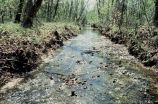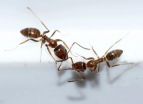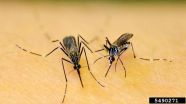(Press-News.org) WASHINGTON, DC -- May 12, 2015-- A multidisciplinary group of US-based researchers has shown that the mixture of species found within natural bacterial communities in the environment can accurately predict the presence of contaminants such as uranium, nitrate, and oil. The findings, published this week in mBio, the online open-access journal of the American Society for Microbiology, show that the rapid sequencing of microbiomes in place at environmental sites can be used to monitor damage caused by human activity.
"This approach might be a general way for us to see anthropogenic effects on the environment," says Terry Hazen, a microbial ecologist at University of Tennessee in Knoxville and Oak Ridge National Laboratory. "It's a way of finding out who's on first? Who is there in the bacterial community that can act as a biosensor and also as potential bioremediators?"
The team hypothesized that because bacteria are already continuously monitoring and responding to changing environmental conditions, then perhaps they could act as an onsite environmental surveillance network. Tracking the make-up of those bacterial communities could be digitized through DNA sequencing.
To find out if bacterial community structure was predictive of contamination, the team employed a method called supervised machine learning, using the Random forest algorithm that relies on an ensemble of thousands of decision trees. For their training set, the team sampled 93 different monitoring wells near Oak Ridge, some of which are known to be contaminated with uranium and nitrate from the early development of nuclear weapons at the site. Teams led by postdoctoral researcher Andrea Rocha took pains to collect the groundwater samples in the same way from each well over a period of three months.
From each sample, the microbial 16S rRNA gene was extracted and sequenced, yielding a total of 26,943 unique species of bacteria. After weeding out the species in very low abundance or narrowly distributed across the well sites, the team was left with 2,972 species to use as 'features' in the machine-learning model.
Then they asked if those features could be used to predict contamination. Using the DNA data, the model could accurately predict uranium contamination of the groundwater 88% of the time and nitrate contamination 73% of the time.
Next, the team wanted to know if their model could work for an altogether different environmental site and contaminant--oil from the Deepwater Horizon spill in the Gulf of Mexico. Using about 60 samples that Hazen's team had previously collected both before and during the 2010 oil spill, the model accurately predicted oil contamination 98% of the time.
Even more impressive, the model could predict the presence of previous contamination in samples where the chemical signature of oil hydrocarbons was absent. In other words, even after the oil had been degraded by bacteria, the presence of a particular bacterial community structure could still identify that the contamination event had taken place.
"This approach may be a sort of forensic tool also," says Hazen. "Even if we cannot detect a contaminant, but we see a community structure that has this predictive ability, then we know there must have been a leak or a spill or people disposing of something in the recent past." The researchers found the approach worked for predicting other geochemical characteristics like pH or the presence of manganese and aluminum as well.
"Today, if I want to know if water is safe to drink, whether it's contaminated with acidity or uranium, it's easier to just go in and measure it directly," explains Mark Smith, research director at OpenBiome in Medford, Massachusetts and former graduate student at Massachusetts Institute of Technology who led the computational analysis. "But we've found these microbial signatures that can persist beyond the direct measurements and that tell us how the bacteria are interacting with their environment." And that, he says, offers another advantage--to help researchers identify bacteria that are enriched at particular sites, which may be involved in the degradation or bioremediation of contaminants.
INFORMATION:
mBio® is an open access online journal published by the American Society for Microbiology to make microbiology research broadly accessible. The focus of the journal is on rapid publication of cutting-edge research spanning the entire spectrum of microbiology and related fields. It can be found online at http://mbio.asm.org.
The American Society for Microbiology is the largest single life science society, composed of over 39,000 scientists and health professionals. ASM's mission is to advance the microbiological sciences as a vehicle for understanding.
Nerve cells that produce dopamine for the purpose of transmitting signals to other cells affect numerous crucial brain functions. This becomes evident in diseases such as Parkinson's and schizophrenia, where dopamine transmission in the brain is impaired. In collaboration with researchers from Bonn, RUB scientists at the Mercator Research Group "Structure of Memory" have now identified in what way a specific form of this important cell is generated and which networks it forms in the course of brain development. In the process, the researchers discovered a data highway of ...
Amsterdam, May 12, 2015 - Wearable E-skin that can measure heart rate and blood pressure, and paper diagnostic machines the size of a credit card that can give instant readings on blood and saliva samples are two new bio-sensing technologies presented at Elsevier's 4th International Conference on Bio-Sensing Technology in Lisbon, Portugal on 12 May 2015.
Bio-sensors can detect and analyze data to give patients information on their heart rate and blood pressure, blood sugar and hormone levels, and even test whether they are infected with antibiotic-resistant bacteria. ...
SAN FRANCISCO, CA--MAY 11, 2015--Scientists have discovered a way to regrow bone tissue using the protein signals produced by stem cells. This technology could help treat victims who have experienced major trauma to a limb, like soldiers wounded in combat or casualties of a natural disaster. The new method improves on older therapies by providing a sustainable source for fresh tissue and reducing the risk of tumor formation that can arise with stem cell transplants.
The new study, published in Scientific Reports, is is the first to extract the necessary bone-producing ...
First there were canaries in coal mines, now there are microbes at nuclear waste sites, oil spills and other contaminated environments. A multi-institutional team of more than 30 scientists has found that statistical analysis of DNA from natural microbial communities can be used to accurately identify environmental contaminants and serve as quantitative geochemical biosensors. This study was sponsored by ENIGMA, a U.S. Department of Energy (DOE) Office of Science "Scientific Focus Area Program" based at the Lawrence Berkeley National Laboratory (Berkeley Lab).
"Changes ...
Researchers at Case Western Reserve University combined finely crafted nanoparticles with one of nature's potent disrupters to prevent the spread of triple-negative breast cancer in mouse models.
The highly aggressive cancer subtype is difficult to manage and, currently, the FDA has no approved targeted treatments. But striking results from a new study, published in the journal Cancer Research make the researchers optimistic they have a potential game-changer for triple negative cancer and more.
"There are multiple targets within a cell," said William Schiemann, professor ...
Pregnant women who exercise can significantly lower the risk of undergoing Caesarean sections and giving birth to large babies, a University of Alberta study has found.
Prenatal exercise has been suggested to be a means to prevent childhood obesity through a "normalization" in birth weight (ie. reducing the risk of having a large baby at birth). University of Alberta researchers conducted a meta-analysis to analyze 28 randomized control studies encompassing 5,322 women that looked at the influence of maternal exercise on baby outcomes.
"We found that women who exercised ...
In a study that compared three sites within the Dja Conservation Complex in Cameroon, Africa, investigators found that the presence of a conservation research project acts as a deterrent to chimpanzee and gorilla poachers, and community awareness and involvement in research lead to an increased value of apes and intact forests to local people, thus limiting hunting practices.
The results provide evidence that the mere existence of research programs exerts a positive impact on the conservation of wildlife in their natural habitats.
"It's important to recognize the effectiveness ...
Mass shootings at the hands of unhinged loners - such as those in Aurora, Colorado; Santa Barbara, California, and Newtown, Connecticut - perpetuate a commonly held belief that mental illness triggers violent crimes.
But a new study from the University of California, Berkeley, shows that hallucinations and delusions associated with psychiatric disorders seldom foreshadow acts of aggression.
In a painstaking review of 305 violent incidents in the United States, the researchers found that only 12 percent were preceded by psychosis. While numerous studies have found that ...
When ants go exploring in search of food they end up choosing collective routes that fit statistical distributions of probability. This has been demonstrated by a team of mathematicians after analysing the trails of a species of Argentine ant. Studies like this could be applied to coordinate the movement of micro-robots in cleaning contaminated areas for example.
Scientists have yet to discover the mechanisms explaining how flocks of birds, shoals of fish, lines of ants and other complex natural systems organise themselves so well when moving collectively.
To tackle ...
Scientists at a U.S. Army research center have modified an assay that tests whether or not a sample of mosquitoes harbors the virus responsible for the disease known as chikungunya (CHIKV), long a problem in the Old World tropics but recently established in the Americas. Their assay is described in an article in the Journal of Medical Entomology.
Health workers now have a quick way to detect the presence of the CHIKV virus within an hour, rather than waiting for results of laboratory tests that take days, or even weeks. It's done with a chemical dipstick, the same kind ...


